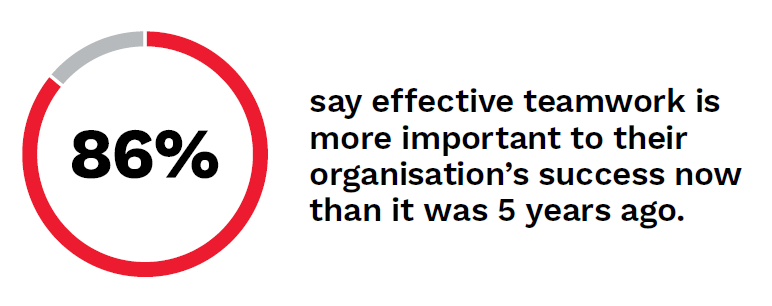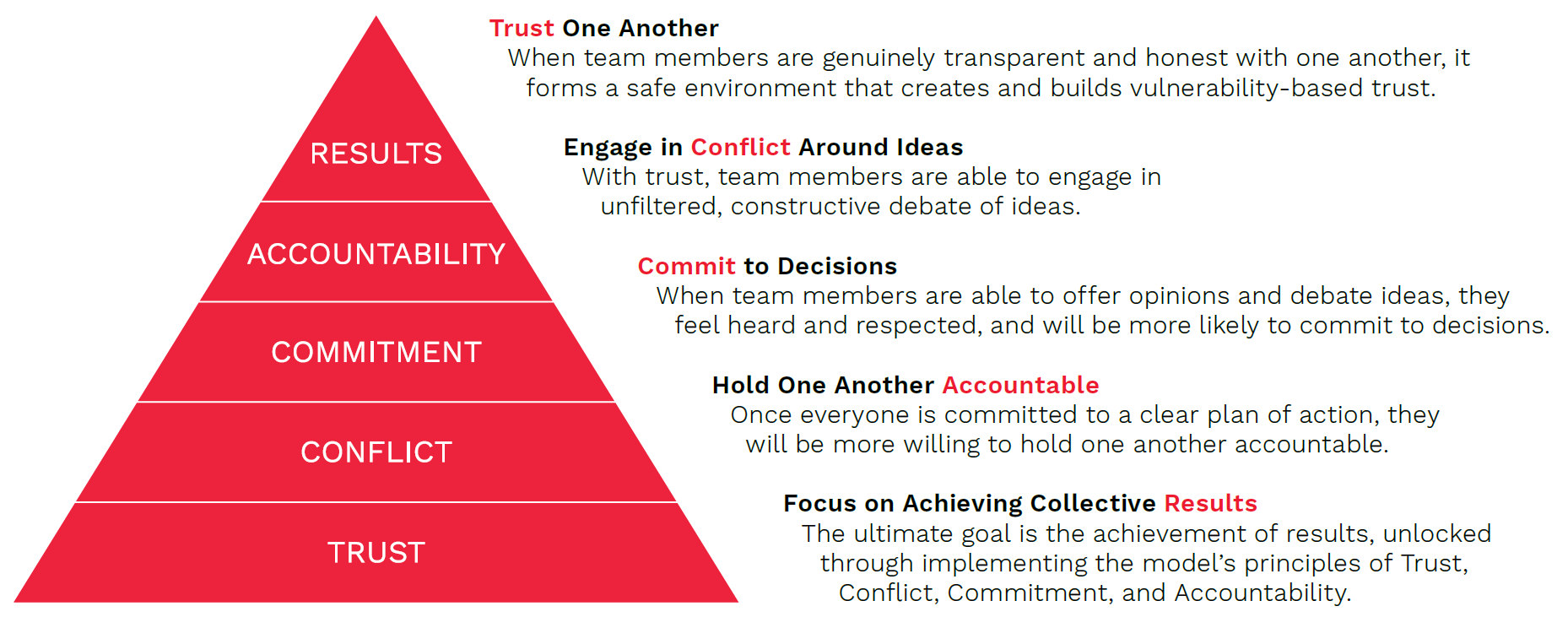

Teams are the building blocks of any organisation1, and our working lives are becoming more team-orientated than ever before.
Over the past several decades, employees have devoted much more of their time to collaboration – in meetings, on phone calls, or via email and chat platforms. Engaging with their team(s) now accounts for over 60% of employees’ time.
This proliferation of teams, however, has complicated employees’ working lives. As teams become more complex, more fluid, and more remote, team members must navigate an environment in constant flux. That’s no easy task, and employees must be flexible, socially adept, and relationship savvy in order to navigate interpersonal challenges and achieve collective gains within and across their teams.
John Wiley & Sons, Inc. conducted a survey in February and early March 2020 to investigate the dynamic nature of teams in the workplace—and how employees and employers are responding2. Based on the responses of over 20,0003 employees across a wide array of industries and organizational positions, from individual contributors to C-suite executives, teams suffer from a critical interpersonal skills gap that impedes their potential to achieve.
Teams in today’s workplace are more complex, more fluid, and more dispersed than ever before.
Over the past several decades, the workplace has undergone considerable change, driven in
part by new technologies, innovation, global competition, and labor outsourcing.
As the need for constant innovation continues apace, organizations find themselves in a
constant state of flux. In response to these external forces, organizations are reshaping
their workplaces and placing new expectations on how and where employees work.
Our research shows that today’s teams are more complex: Employees work on more teams and
with more people on a daily basis compared to just five years ago. 76% of employees are part
of at least two teams within their organization, most often working on two to three teams.

Not only do people work on more teams, but they work on more types of teams, as well. 73% of respondents are part of at least two different types of teams, whether project-based, departmental, or matrix. Some types of teams are more fluid than others. A matrix team, for example, requires employees to swiftly learn and adapt to the working approaches and mindsets of their counterparts in other departments. Other types, like project-based teams, most often last just a few months. In that time, employees quickly come together, form bonds, produce work, and disassemble. This is especially salient for the 41% of respondents who have worked on teams with consultants and temporary contractors. Stability on teams can be challenging to find!


Moreover, their teammates are increasingly
physically distant, which exacerbates the challenges of becoming successful teams. In the past year, 28% of respondents have worked with at least one member based in another country, and 51% have worked on teams with at least one member who collaborated virtually. As remote work proliferates post COVID-19, we expect this
number to increase considerably.

The changing workplace poses real challenges for employees of all roles and responsibilities. These dramatic shifts—in the number, type, and geographical distribution of teams—require that employees possess a certain interpersonal skillset for effective teamwork, one that they can bring to any team they’re a part of. The problem, though, is that the behaviors within this skillset can be difficult to recognise, let alone adopt.

Individuals suffer from a critical teamwork skill gap in the workforce
Despite the pressing need for highly effective and productive teams, many individuals are either unaware or unable to consistently practice the behaviors that will ensure team success. This is primarily because employees see teamwork as something that comes naturally to them and as learned only through personal experiences on teams. In other words, they don’t view teamwork as something they need to learn, especially when 99% of respondents consider themselves “good” and “effective” team members.

Yet this optimism is belied by our historical The Five Behaviors® assessment data—compiled over 2019 from more than 13,000 participants in The Five Behaviors program—which paint a much bleaker picture. Looking at team performance through the lens of Patrick Lencioni’s The Five Dysfunctions of a Team, we see considerable room for improvement across several crucial behaviors.

The Reality of Teamwork



The consequences of this skill gap are astounding for individuals, teams, and employers.
The inability of many individuals to meet the
changing demands of their workplaces costs
their employees—and themselves!—dearly. Not
only do inefficient teams and poor teammates
hinder organizations’ competitiveness, but they affect productivity and workplace culture, too. What’s more, inefficient teams create greater employee turnover due to lower job satisfaction.
Productivity nosedives: Respondents report
being on teams where a lack of cohesion
(88%), an inability to hold each other
accountable (80%), and a lack of trust
(61%) all hurt their team’s productivity.
That means the majority of teams
are not performing at their full potential.
Time and money are wasted dealing with
ineffective teamwork: On average, employees spend about 7 hours per week—almost an entire workday—dealing with the effects of poor teamwork, whether covering for
someone else not pulling their weight, discussing problematic team members with others, or redoing work because of unclear objectives.
Work culture is more toxic: 71% of respondents tell us they have been on teams where a lack of trust created a toxic work environment.
Time and money are wasted dealing with ineffective teamwork

The words below epitomise what respondents consider a “bad team member.” Employees who are lazy, selfish, or negative bring down teams’ and organisations’ morale. Unsurprisingly then, 9 in 10 people feel their organisational culture would improve if people were more effective teammates.


High stress means high turnover: 63% of respondents feel their job satisfaction would improve if their coworkers were better teammates. That’s because half of respondents tell us that working with difficult team members causes them the most stress at work. In fact, bad team experiences led a full 4 in 10 people to leave their jobs.
These results show – with crystal clarity – what happens when the building blocks of organizations do not work. And it means that effective teamwork matters more now than ever. Organizations must address this glaring gap in interpersonal skills to attract and maintain top talent and a competitive edge.

Despite how much the quality of teamwork matters, most people aren’t sure how to be a more effective team member, and organizations are focusing on the wrong tools to address the skill gap.
Employees know teamwork matters, and they know what it looks like, as shown in the image to the right. Respondents consider a “good team member” as an effective communicator, a willing collaborator, and a reliable and accountable worker.
But knowing what effective teamwork should be is a lot different from knowing how to be an effective team member. To this end, our research finds large disparities in what respondents think is important when working on a team. There is disagreement about whether to keep your head down and focus on your own work, as opposed to questioning others’ approaches and methods, as well as whether it’s important to achieve group consensus on decisions, instead of committing to decisions that you disagree with.
This uncertainty speaks to how little most employees know about what good teamwork requires. Based on our research and Wiley’s The Five Behaviors products, we have found that successful team members trust and can be vulnerable with one another, engage in healthy conflict around issues while ultimately committing to decisions, and hold each other accountable to achieve their best results.
How people described
qualities of a “good team member.”

Which is more important when working on a team?


As we all know, addressing the interpersonal issues that prevent effective teamwork is no easy task. It’s often quicker and easier to embrace technological tools to address the problem. Many organisations have done just that by embracing the global proliferation of team collaboration tools—an industry valued between $2.7 and 8.2 billion5. These technologies—from project management platforms to clouds and video conferencing—aim to centralize projects, streamline communications, and increase efficiency.



The good news is that
nearly everyone agrees that teamwork skills can be
developed and improved.
Employees strike a cheerful tone in agreeing that, in general, teamwork skills can be developed. Of course, they may not feel their own skills need improvement, since our survey results suggest an exaggerated level of confidence. Even so, virtually everyone in our study agrees that taking the time to develop effective teamwork skills is worthwhile. And 98% of managers, directors, and executives believe skill development is absolutely worth their team’s time.


Developing those teamwork skills is also critical to the organization’s success. 86% of respondents stated that effective teamwork—specifically, the ability to work with others to achieve results—is more important to their collective success now than it was just five years ago!
Fortunately, this means organizations can address the interpersonal skill gaps among employees and overcome—or, better yet, avoid—the staggering cost of ineffective teamwork by training and developing their workforce. Only by creating a working environment that values and promotes the building blocks of collective teamwork—from trust and commitment to accountability—and rewards high-performing teams, can organizations reap the benefits of efficient and effective teamwork.

The state of teams after COVID-19.
The repercussions of COVID-19 have been vast and consequential, touching each of us and the organisations we work for. Many employees transitioned – almost overnight – from onsite employees to members of teams that work exclusively from home. With government and business officials alike mandating remote work, the state of teams changed in the blink of an eye.


Research from John Wiley & Sons, Inc. conducted in March 2020 surveyed learners about their adjustment to virtual collaboration. The results showed that, of the organisations that recommended or mandated remote work, 22% of employees identified as not confident that their teams could maintain the same production and performance while working and collaborating virtually. And nearly a third (29%) indicated they are not confident that their team members will feel personally connected as they continue to collaborate virtually.
As many more teams have now become physically separated, the need for a strong foundation of teamwork and communication among colleagues is more important than ever before.

Fortunately, there is a model for effective teamwork
In his best-selling book, The Five Dysfunctions of a Team, Patrick Lencioni, introduces a powerful and approachable model for effective teamwork and collaboration. According to Lencioni, there are five key behaviors that a team must
Research from John Wiley & Sons, Inc. conducted in March 2020 surveyed learners about their adjustment to virtual collaboration. The results showed that, of the organisations that recommended or mandated remote work, 22% of employees identified as not confident that their teams could maintain the same production and performance while working and collaborating virtually. And nearly a third (29%) indicated they are not confident that their team members will feel personally connected as they continue to collaborate virtually.
The Five Behaviors Model


Trust One Another
When team members are genuinely transparent and honest with one another, it forms a safe environment that creates and builds vulnerability-based trust.
Engage in Conflict Around Ideas
With trust, team members are able to engage in unfiltered, constructive debate of ideas.
Commit to Decisions
When team members are able to offer opinions and debate ideas, they feel heard and respected, and will be more likely to commit to decisions.
Hold One Another Accountable
Once everyone is committed to a clear plan of action, they will be more willing to hold one another accountable.
Focus on Achieving Collective Results
The ultimate goal is the achievement of results, unlocked through implementing the model’s principles of Trust, Conflict, Commitment, and Accountability.

The Five Behaviors® can change the way you team
The Five Behaviors® is the result of a partnership between Wiley and bestselling author Patrick Lencioni’s groundbreaking model for developing highperforming teams through five key behaviors: Trust, Conflict, Commitment, Accountability, and Results. This powerful training teaches participants the critical behaviors and interpersonal skills needed to work together effectively by combining Lencioni’s teamwork model with personalized insights. The result is a unique and impactful team development solution that empowers team members rethink their approach to teamwork, shape new, more productive behaviors to increase productivity, and create a common language that completely redefines what it means to work together to drive results. Learn more.
Study Notes and References
- DiazGranados, Deborah, Marissa L. Shuffler, Jesse A. Wingate, and Eduardo Salas. 2017. “Team Development Interventions” in The Wiley Blackwell Handbook of the Psychology of Team Working and Collaborative Processes. Hoboken, NJ: John Wiley & Sons, Inc.
- We asked respondents a range of questions aimed at understanding their involvement on teams and engagements with team members. This included questions about the characteristics of teams they’re on, ineffective teamwork and its consequences, and the frequency and importance of various team behaviors.
- Based primarily in the United States.
- According to the Bureau of Labor Statistics, there are 118.3 million full-time workers in the U.S. in 2019. Their median weekly earnings were $936, yielding an hourly wage of $23.40. https://www.bls.gov/news.release/pdf/wkyeng.pdf
- According to IDC’s Worldwide Team Collaborative Applications Market Shares, 2018 and Grand View Research’s Team Collaboration Software Market Analysis Report, 2018.
Get in touch
Let us help you fix the challenges in your organisation